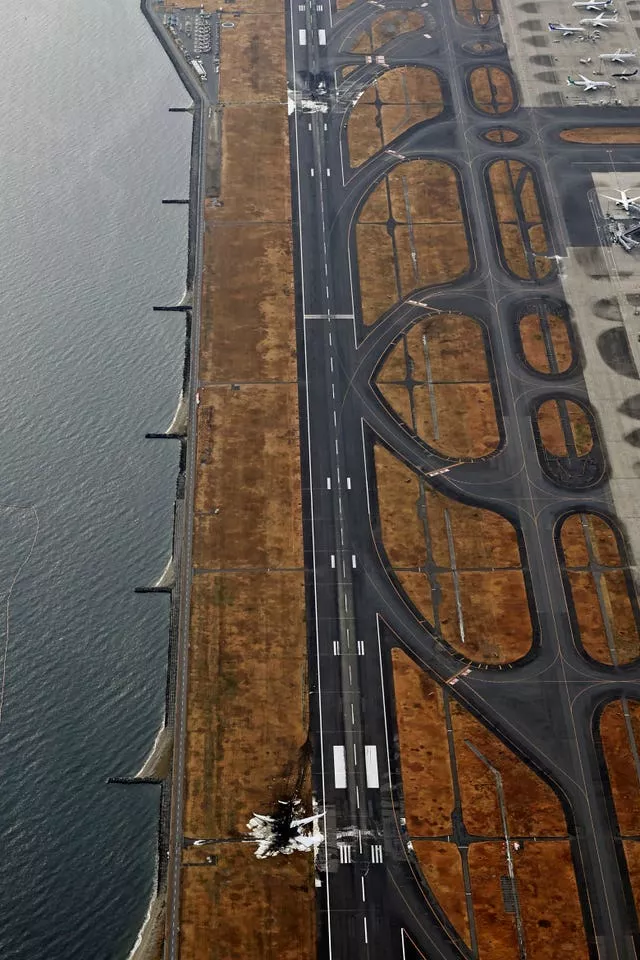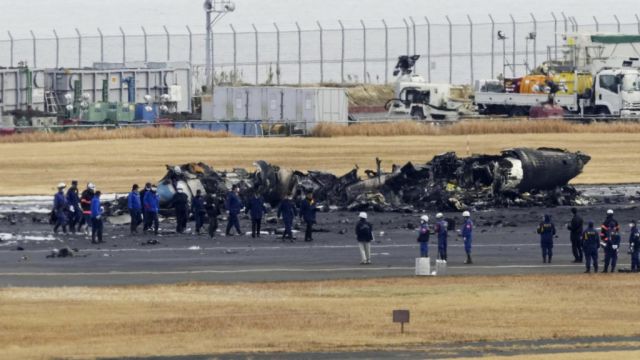Transport officials and police began separate investigations at Tokyo’s Haneda Airport on Wednesday, a day after a large passenger plane and a Japanese coast guard aircraft collided on the runway and burst into flames, killing five people.
The accident happened on Tuesday evening when Japan Airlines flight JAL-516 landed on one of Haneda’s four runways as the coast guard aircraft – a Bombardier Dash-8 – was preparing to take off. Both sides said they had received the go-ahead from aviation officials.
An orange fireball erupted from the aircraft, and the JAL plane continued down the runway covered in flames while spewing grey smoke.
Within 20 minutes, all 379 passengers and crew members slid down emergency chutes and survived.
The pilot of the coast guard plane, which exploded, escaped with injuries but five crew members were killed.

Transport safety officials were focusing on communication between air traffic control officials and the two aircraft to determine what led to the collision.
Police began a separate inquiry into possible professional negligence.
On Wednesday, Tokyo police said investigators have examined the debris on the runway and are to interview the involved parties.
The Japan Airlines Airbus A350 had flown from Shin Chitose airport near the northern Japanese city of Sapporo, and the coast guard Bombardier was preparing to depart for Niigata to deliver relief supplies to residents in the central regions hit by powerful earthquakes on Monday that killed more than 60 people.
On Wednesday, six experts from the Japan Transport Safety Board examined what remained of the aircraft, the board said.
TV footage showed the severely damaged A350’s wings among the charred, broken parts of fuselages. The smaller coast guard plane looked like a mound of rubble.
Transport safety investigators plan to interview the pilots and officials from both sides, as well as air traffic control officials to find out how the two planes simultaneously ended up on the runway, JTSB said.

The two sides had different understandings of their permission to use the runway.
JAL managing executive officer Tadayuki Tsutsumi told a news conference late on Tuesday that the A350 was making a “normal entry and landing” on the runway. Another JAL executive, Noriyuki Aoki, said the flight had received permission to land from aviation officials.
The air traffic officials gave the JAL airliner landing permission, while telling the coast guard pilot to wait before entering the runway, NHK television reported on Wednesday.
But the Bombardier pilot said he had also been given permission to take off, and the coast guard said officials are verifying that claim.
All passengers and crew members on board the commercial flight left their baggage and slid down the escape chutes within 20 minutes of the landing as smoke filled the cabin of the burning aircraft – an outcome praised by aviation experts.
Videos posted by passengers showed people covering their mouths with handkerchiefs as they ducked down and moved toward the exits. Some passengers told news media they felt safe only after reaching a grassy area beyond the tarmac.
“The entire cabin was filled with smoke within a few minutes. We threw ourselves down on the floor. Then the emergency doors were opened and we threw ourselves at them,” Swedish passenger Anton Deibe, 17, told Swedish newspaper Aftonbladet. “The smoke in the cabin stung like hell.”
The fire is likely to be seen as a key test case for plane fuselages made from carbon-composite fibres – featured on the A350 and the Boeing 787 – instead of conventional aluminium skins.

Safety consultant John Cox said: “This is the most catastrophic composite-airplane fire that I can think of. On the other hand, that fuselage protected (passengers) from a really horrific fire – it did not burn through for some period of time and let everybody get out.”
Haneda’s three other runways reopened late on Tuesday, but some 100 flights have been cancelled due to the closure of the accident-hit runway.
The airport was packed on Wednesday as many holidaymakers ended their New Year travel, including those who who survived the fire and spent the night at the airport or at nearby hotels, trying to change their flights.
Haneda is the busier of the two major airports serving the Japanese capital, with many international flights, and is favoured by business travellers due to its proximity to central parts of the city.
Tuesday’s accident was the first severe damage to an Airbus A350, which is among the industry’s newest large passenger planes, having entered commercial service in 2015.
Airbus said in a statement that it is sending specialists to help Japanese and French officials investigating the accident, and that the plane was delivered to Japan Airlines in late 2021.
JAL operates 16 of the A350-900 version aircraft, according to its website. The twin-engine, twin-aisle A350 is used by a number of long-haul international carriers. More than 570 of the aircraft are in operation, according to Airbus.







